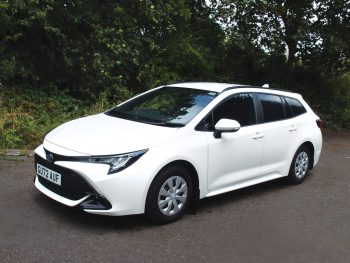Practical improvements and greater efficiency bode well for revised car-derived van, says John Kendall.

WHAT IS IT? Car-derived van
PRICE? From £24,533.33 (ex-VAT OTR)
MAX PAYLOAD? 425kg
ECONOMY? 64.2mpg (combined WLTP)
DRIVE? 1.8-litre petrol, with 70kW electric motor, FWD. Total output 140hp
As soon as we had handed our long-term test Corolla Commercial back earlier this year, Toyota announced a replacement for it, when the model was only just over a year old. Since the Corolla Commercial is based on the Corolla Touring Sports five-door estate passenger model produced at Toyota’s Burnaston plant near Derby, it automatically gained the updates made to the passenger car variant, even though it was a relatively new van model.
We described the principal changes earlier this year when the new model was launched. These included Toyota’s fifth- generation hybrid technology, which incidentally gave the 1.8-litre petrol engine more power, a smaller, lighter lithium-ion battery and a programme of weight reduction and improved efficiency. The transaxle is now 15% lighter thanks to a more compact electric motor. Then there are smart upgrades such as gathering data about regular journeys and journeys made using satellite navigation to improve efficiency.
Do these changes lead to practical improvements? In short, yes. The most noticeable improvement, compared with our long-term test vehicle is that the overall fuel consumption is better by a couple of MPG. We were fairly impressed with the fuel consumption before, but the new model proved consistently better during our test. We logged over 60mpg on average, something we couldn’t quite achieve with our long-term test vehicle and not far off the 64.2mpg official combined figure. There are too many tweaks to the hybrid system to list them all, but clearly the effect of all the little changes has been beneficial.
One of the criticisms usually levelled at vehicles with CVT is that the engine speed is not always related to vehicle speed. That is unavoidable to a point because the transmission does not have fixed ratios and will choose the optimum engine speed for the conditions, but it can make the engine sound a bit frantic when running downhill or decelerating, for instance. Toyota has tweaked that slightly to make it less apparent – possible because the CVT operates as part of the hybrid system and regenerative braking can be a substitute for engine braking.
The tweaks to the Toyota Safety Sense system will be less apparent but have resulted in a more responsive adaptive cruise control (ACC) system. These are more extensive than that but would mostly only be experienced in an emergency.
Toyota has decided to offer the Corolla Commercial with a single specification, so items such as ACC are included as standard, along with a multimedia system with eight-inch central display, Android Auto and Apple CarPlay, over-the-air updates for multimedia and safety system software, heated front seats with power lumbar adjustment, a reversing camera, automatic headlights and several other items. It is undoubtedly well-equipped.
The driving experience is, as expected, broadly similar to the earlier model. It’s a comfortable van that handles well and offers good performance and economy. It provides a small but useful load space. Retaining the rear side doors gives good access to the front of the load area behind the bulkhead, there’s even enough room to fit a small bag in front of the bulkhead and behind the front seat if you need to keep items out of sight.
Verdict
The latest Corolla Commercial is a subtly better van than before, offering better performance, together with reduced fuel consumption. If you need a small hatchback van, it’s the one to beat.

